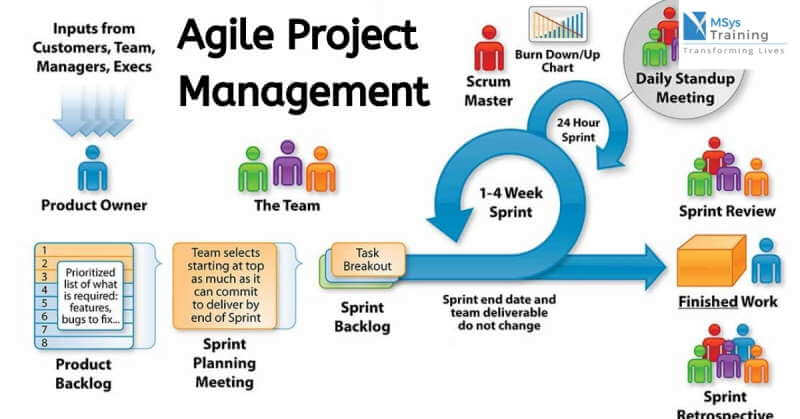What is Agile Project Management?
Agile project management has gained immense popularity in recent times and is now considered one of the most effective ways to manage projects.
Its flexible, iterative approach allows teams to respond quickly to changing requirements and adapt their processes accordingly. However, for those who are new to the concept, understanding what it is and how it works can be a challenge.
In this article, we will explore the fundamentals of agile project management – its principles, methodologies, tools and techniques – so that you can gain a better understanding of how it works and whether it could be beneficial for your team or organization.
Agile Project Management is an incremental method of project delivery that occurs throughout the project’s life cycle. Iterative or agile life cycles involve numerous iterations or incremental steps toward project completion.
Iterative techniques are commonly used in software development projects to enhance velocity and flexibility since iteration allows you to make changes as you go rather than following a linear path. One goal of an agile or iterative strategy is to provide advantages throughout the process rather than just at the conclusion.
What are the characteristics of agile project management?
1. Customer Contentment
Customer satisfaction is always of the utmost importance. With this in mind, end-users take an active role in the process, offering input that the team members evaluate and act on to improve the final product’s quality. Finally, the success or failure of an Agile project must be primarily determined by the satisfaction of consumers with the results.
2. Delivery in Record Time
Compared to traditional methodologies, the potential to reduce the amount of time between the start of the planning phase and the delivery of the product is a significant advantage of the Agile approach. The delivery time of an Agile project is often more predictable and faster than that of a traditional project because the project team is not required to have everything perfect before releasing it. With an Agile methodology, building completely functional software in a much shorter amount of time should be possible.
3. Continual Improvement
Agile project management is based on the philosophy that a successful project is one where the team can respond to feedback from the business stakeholders. This is what agile project management is about.
It is critical to realise that change is accepted in Agile project management. Throughout the project’s life cycle, the needs, emphasis, or even the project’s scope can change, and with Agile, teams may welcome this rather than perceive it as negative or troublesome.
4. Concentrate on Collaboration
Another distinguishing feature of Agile project management is collaboration and cooperation. This happens when you collaborate with your team and clients and keep on track with your projects; End users are also included in this collaborative approach.
The Agile method works best when business people and project developers work together, at least a portion of the time. Agile projects may respond to input much sooner by incorporating users in the process as well.
5. Increased Transparency
Because end-users are actively involved in the process and can observe the ongoing progress, the Agile method of project management provides a higher level of transparency. From the standpoint of the company, the trade-off is that end-users may perceive faults.
6. Test Early
The key premise of product testing in an Agile project is to test early and often. Problems may be recognised and addressed more quickly and readily if this frequent testing is integrated throughout the product’s life cycle. One significant advantage of this technique to testing is that mistakes, difficult coding, bugs, and other issues are identified and resolved more quickly. This eliminates the danger that they will be postponed and subsequently forgotten about.
7. Frequently Take One Step at a Time
While the Agile methodology is all about adaptation, any successful Agile project management will emphasise the need for structure and a sequential approach to project management.
In layman’s words, this implies completing one element of the project before moving on to the next, and this idea helps keep projects on pace. Each new project stage is constructed on firm foundations by finishing each specific component before going on to the next. This method also helps to assure consistency across the project’s life cycle.
8. Employees Who Are Self-Driven
Agile also has an advantage for project managers in that it reduces the amount of micromanagement required. This is because people and teams are trusted, and the system emphasises the need to be self-motivated, self-directed, and self-organised.
9. Effective Communication
Most projects, when they begin, have an established set of goals and objectives. The most crucial aspect of the success of a project is communication between the team members and the management team. Communication is needed to stay on task and tackle any challenges. With all parties aligned, a project can be successful more timely with reduced risk.
Excellent communication will always be highlighted in project management and DevOps training, but the Agile methodology also promotes efficient communication. This entails employing the quickest and most appropriate solution for the circumstances and embracing cutting-edge communication technologies.
10. The Ideal End Product
Finally, one of the most important aspects of Agile projects is the emphasis on providing the proper end result based on what consumers truly want and need. This means that success is measured by producing a precious final result rather than just completing the agreed-upon project.
There is no value in ‘successfully’ finishing a project that does not genuinely solve what real consumers are experiencing. The ultimate output of the project must be suitable for the target users.

What are the 3 key elements of agile methodology?
Several issues must be addressed if an agile project is to provide the required outcomes within the allocated budget. First and foremost, a choice must be made at the outset of a project as to whether agile is the best method for completing it. If agile is determined to be the best development technique to adopt. In that case, the following three factors will help the project succeed: collaboration, constant focus on business value, and appropriate quality.
Also Read: What is The Iron Triangle of Project Management?
What are the disadvantages of Agile methodology?
1) Inadequate resource planning
Because Agile is predicated on the premise that teams won’t know what their ultimate product (or even a few cycles of delivery down the road) will look like from the start, it’s difficult to anticipate project costs, time, and resources from the outset (and this challenge becomes more pronounced as projects get bigger and more complex).
2) There is a scarcity of documentation.
Documentation is done throughout an Agile project and frequently “just in time” for generating the output, rather than at the start. As a result, it gets less detailed and frequently goes to the bottom of the priority list.
3) Output that is fragmented
Incremental delivery may help get goods to market faster, but Agile is also a significant drawback. Because teams work on each component in separate cycles, the final product is sometimes fragmented rather than a single coherent item.
4) There is no conclusion in sight.
It’s easy to get sidetracked offering new, unanticipated features because Agile needs less preparation at the start. Furthermore, projects have no end because there is never a clear idea of the “finished result”.
5) Measurement is difficult.
Because Agile works in chunks, monitoring progress necessitates looking over several cycles. And because the project is “see-as-you-go,” you won’t be able to set many KPIs at the outset. Because of the game’s length, it’s impossible to track your progress.
Why is the Agile model best?
Agile has emerged as the go-to paradigm for assisting app startups and development companies in creating high-quality software rapidly and effectively. Agile enhances value throughout the development process while considerably lowering total project risk.
Agile development is a process rather than a tool. It’s an iterative strategy for software development that produces software progressively rather than delivering the finished result towards the end of the schedule. This method is simple and adaptable, allowing you to adjust as needed.

